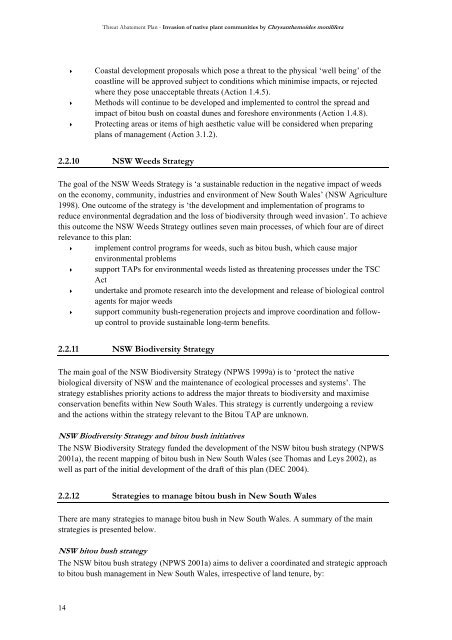NSW Bitou Bush Threat Abatement Plan - Department of ...
NSW Bitou Bush Threat Abatement Plan - Department of ...
NSW Bitou Bush Threat Abatement Plan - Department of ...
Create successful ePaper yourself
Turn your PDF publications into a flip-book with our unique Google optimized e-Paper software.
14<br />
<strong>Threat</strong> <strong>Abatement</strong> <strong>Plan</strong> - Invasion <strong>of</strong> native plant communities by Chrysanthemoides monilifera<br />
< Coastal development proposals which pose a threat to the physical ‘well being’ <strong>of</strong> the<br />
coastline will be approved subject to conditions which minimise impacts, or rejected<br />
where they pose unacceptable threats (Action 1.4.5).<br />
< Methods will continue to be developed and implemented to control the spread and<br />
impact <strong>of</strong> bitou bush on coastal dunes and foreshore environments (Action 1.4.8).<br />
< Protecting areas or items <strong>of</strong> high aesthetic value will be considered when preparing<br />
plans <strong>of</strong> management (Action 3.1.2).<br />
2.2.10 <strong>NSW</strong> Weeds Strategy<br />
The goal <strong>of</strong> the <strong>NSW</strong> Weeds Strategy is ‘a sustainable reduction in the negative impact <strong>of</strong> weeds<br />
on the economy, community, industries and environment <strong>of</strong> New South Wales’ (<strong>NSW</strong> Agriculture<br />
1998). One outcome <strong>of</strong> the strategy is ‘the development and implementation <strong>of</strong> programs to<br />
reduce environmental degradation and the loss <strong>of</strong> biodiversity through weed invasion’. To achieve<br />
this outcome the <strong>NSW</strong> Weeds Strategy outlines seven main processes, <strong>of</strong> which four are <strong>of</strong> direct<br />
relevance to this plan:<br />
< implement control programs for weeds, such as bitou bush, which cause major<br />
environmental problems<br />
< support TAPs for environmental weeds listed as threatening processes under the TSC<br />
Act<br />
< undertake and promote research into the development and release <strong>of</strong> biological control<br />
agents for major weeds<br />
< support community bush-regeneration projects and improve coordination and followup<br />
control to provide sustainable long-term benefits.<br />
2.2.11 <strong>NSW</strong> Biodiversity Strategy<br />
The main goal <strong>of</strong> the <strong>NSW</strong> Biodiversity Strategy (NPWS 1999a) is to ‘protect the native<br />
biological diversity <strong>of</strong> <strong>NSW</strong> and the maintenance <strong>of</strong> ecological processes and systems’. The<br />
strategy establishes priority actions to address the major threats to biodiversity and maximise<br />
conservation benefits within New South Wales. This strategy is currently undergoing a review<br />
and the actions within the strategy relevant to the <strong>Bitou</strong> TAP are unknown.<br />
<strong>NSW</strong> Biodiversity Strategy and bitou bush initiatives<br />
The <strong>NSW</strong> Biodiversity Strategy funded the development <strong>of</strong> the <strong>NSW</strong> bitou bush strategy (NPWS<br />
2001a), the recent mapping <strong>of</strong> bitou bush in New South Wales (see Thomas and Leys 2002), as<br />
well as part <strong>of</strong> the initial development <strong>of</strong> the draft <strong>of</strong> this plan (DEC 2004).<br />
2.2.12 Strategies to manage bitou bush in New South Wales<br />
There are many strategies to manage bitou bush in New South Wales. A summary <strong>of</strong> the main<br />
strategies is presented below.<br />
<strong>NSW</strong> bitou bush strategy<br />
The <strong>NSW</strong> bitou bush strategy (NPWS 2001a) aims to deliver a coordinated and strategic approach<br />
to bitou bush management in New South Wales, irrespective <strong>of</strong> land tenure, by:
















